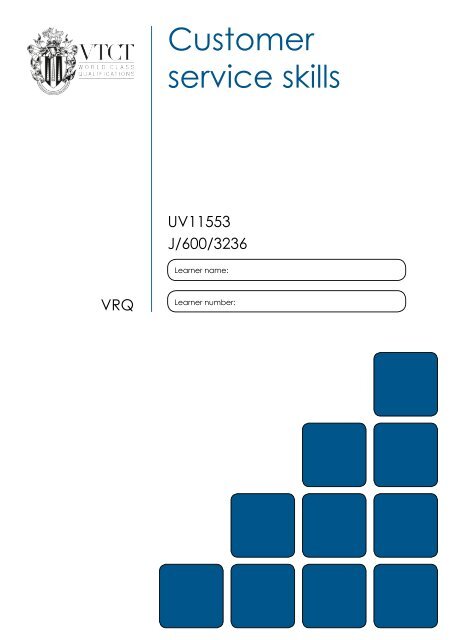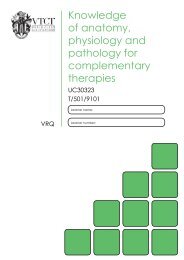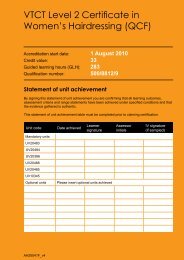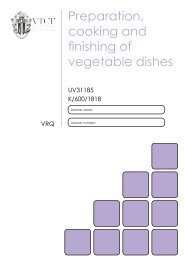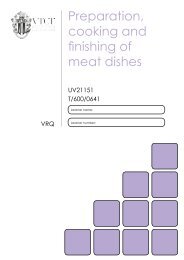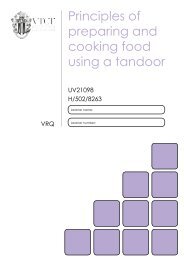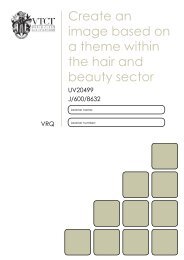Customer service skills - VTCT
Customer service skills - VTCT
Customer service skills - VTCT
Create successful ePaper yourself
Turn your PDF publications into a flip-book with our unique Google optimized e-Paper software.
VRQ<br />
<strong>Customer</strong><br />
<strong>service</strong> <strong>skills</strong><br />
UV11553<br />
J/600/3236<br />
Learner name:<br />
Learner number:
Statement of unit achievement<br />
By signing this statement of unit achievement you are confirming that all learning outcomes, assessment<br />
criteria and range statements have been achieved under specified conditions and that the evidence<br />
gathered is authentic.<br />
This statement of unit achievement table must be completed prior to claiming certification.<br />
Unit code Date achieved Learner signature<br />
Assessor tracking table<br />
<strong>VTCT</strong> is the specialist awarding body for the Hairdressing, Beauty Therapy, Complementary<br />
Therapy, Hospitality and Catering and Sport and Active Leisure sectors, with over 45 years of<br />
experience.<br />
<strong>VTCT</strong> is an awarding body regulated by national organisations including Ofqual, SQA, DfES and<br />
CCEA.<br />
<strong>VTCT</strong> is a registered charity investing in education and <strong>skills</strong> but also giving to good causes in<br />
the area of facial disfigurement.<br />
Assessor name Assessor signature<br />
Assessor<br />
initials<br />
Assessors<br />
initials<br />
IV signature<br />
(if sampled)<br />
All assessors using this Record of Assessment book must complete this table. This is required for<br />
verification purposes.<br />
Assessor number<br />
(optional)
UV11553<br />
<strong>Customer</strong> <strong>service</strong> <strong>skills</strong><br />
The aim of this unit is to develop your knowledge and<br />
understanding of customer <strong>service</strong> <strong>skills</strong>. You will learn<br />
about the principles of customer <strong>service</strong> and the benefits<br />
of good customer <strong>service</strong> to an organisation. You will<br />
also learn about the impact of poor customer <strong>service</strong> on<br />
customers, the organisation and staff.<br />
You will understand the value of first impressions and the<br />
impact of positive verbal and non-verbal interaction with<br />
customers.<br />
UV11553_v6
Level<br />
Credit value<br />
GLH<br />
1<br />
3<br />
27<br />
Observation(s)<br />
0<br />
External paper(s)<br />
0
<strong>Customer</strong> <strong>service</strong> <strong>skills</strong><br />
Learning outcomes Evidence requirements<br />
On completion of this unit you will:<br />
1. Understand the principles of customer<br />
<strong>service</strong><br />
2. Understand the benefits to an organisation<br />
of good customer <strong>service</strong><br />
3. Understand the possible consequences of<br />
poor customer <strong>service</strong><br />
4. Understand the value of first impressions<br />
5. Understand positive verbal and non-verbal<br />
interaction with customers<br />
6. Understand the importance of respect for<br />
the individual in relation to good customer<br />
<strong>service</strong><br />
1. Knowledge outcomes<br />
There must be evidence that you possess<br />
all the knowledge and understanding<br />
listed in the Knowledge section of this<br />
unit. This evidence may include projects,<br />
assignments, case studies, reflective<br />
accounts, oral/written questioning and/or<br />
other forms of evidence.<br />
2. Tutor/Assessor guidance<br />
You will be guided by your tutor/assessor<br />
on how to achieve learning outcomes in this<br />
unit. All outcomes must be achieved.<br />
3. External paper<br />
There is no external paper requirement for<br />
this unit.<br />
UV11553 3
4<br />
Developing knowledge<br />
Achieving knowledge outcomes<br />
You will be guided by your tutor and assessor<br />
on the evidence that needs to be produced.<br />
Your knowledge and understanding will be<br />
assessed using the assessment methods listed<br />
below*:<br />
• Projects<br />
• Observed work<br />
• Witness statements<br />
• Audio-visual media<br />
• Evidence of prior learning or attainment<br />
• Written questions<br />
• Oral questions<br />
• Assignments<br />
• Case studies<br />
• Professional discussion<br />
Where applicable your assessor will integrate<br />
knowledge outcomes into practical observations<br />
through professional discussion and/or oral<br />
questioning.<br />
When a criterion has been orally questioned<br />
and achieved, your assessor will record this<br />
evidence in written form or by other appropriate<br />
means. There is no need for you to produce<br />
additional evidence as this criterion has already<br />
been achieved.<br />
Some knowledge and understanding outcomes<br />
may require you to show that you know and<br />
understand how to do something. If you have<br />
practical evidence from your own work that<br />
meets knowledge criteria, then there is no<br />
requirement for you to be questioned again on<br />
the same topic.<br />
*This is not an exhaustive list.<br />
UV11553
Knowledge<br />
Learning outcome 1<br />
Understand the principles of customer <strong>service</strong><br />
You can: Portfolio reference<br />
a. Outline the principles of customer <strong>service</strong><br />
UV11553 5
6<br />
Learning outcome 2<br />
Understand the benefits to an organisation of good customer<br />
<strong>service</strong><br />
You can: Portfolio reference<br />
a. Identify examples of good practice in customer <strong>service</strong><br />
b. Outline how good customer <strong>service</strong> promotes customers’<br />
confidence in the organisation<br />
c. Outline why good customer <strong>service</strong> is important for an organisation<br />
UV11553
Learning outcome 3<br />
Understand the possible consequences of poor customer<br />
<strong>service</strong><br />
You can: Portfolio reference<br />
a. Outline how poor customer <strong>service</strong> can impact on:<br />
• customers<br />
• the organisation itself<br />
• staff<br />
b. Outline the effects of poor customer <strong>service</strong> on an organisation’s<br />
reputation<br />
UV11553 7
8<br />
Learning outcome 4<br />
Understand the value of first impressions<br />
You can: Portfolio reference<br />
a. Outline why it is important to make a good first impression<br />
b. Outline ways of creating a positive first impression when<br />
communicating:<br />
• face-to-face<br />
• on the telephone<br />
• in writing<br />
UV11553
Learning outcome 5<br />
Understand positive verbal and non-verbal interaction with<br />
customers<br />
You can: Portfolio reference<br />
a. Outline what is meant by non-verbal communication<br />
b. Identify appropriate and inappropriate ways of communicating<br />
verbally with customers<br />
c. Outline ways in which non-verbal communication can be used<br />
positively to support face-to-face communication<br />
UV11553 9
10<br />
Learning outcome 6<br />
Understand the importance of respect for the individual in<br />
relation to good customer <strong>service</strong><br />
You can: Portfolio reference<br />
a. Outline the importance of maintaining customer confidentiality<br />
b. Outline the factors that need to be taken into account to maintain<br />
customer confidentiality<br />
c. Outline ways of respecting individual customer needs from a range<br />
of different cultures and backgrounds<br />
UV11553
Unit content<br />
This section provides guidance on the recommended knowledge and <strong>skills</strong> required to enable you<br />
to achieve each of the learning outcomes in this unit. Your tutor/assessor will ensure you have the<br />
opportunity to cover all of the unit content.<br />
Learning outcome 1: Understand the principles of customer <strong>service</strong><br />
Principles of customer <strong>service</strong>: Quality,<br />
keeping promises, managing customer<br />
expectations, customer satisfaction, speed<br />
of <strong>service</strong>.<br />
Learning outcome 2: Understand the benefits to an organisation of good<br />
customer <strong>service</strong><br />
Examples of good practice in customer<br />
<strong>service</strong>: Applied to real working scenarios,<br />
e.g. meeting and exceeding customer<br />
needs and expectations, adding a personal<br />
touch, making extra efforts to demonstrate<br />
willingness, treating the customer as an<br />
individual, dealing quickly and effectively<br />
with a complaint.<br />
How good customer <strong>service</strong> promotes<br />
customers’ confidence: <strong>Customer</strong><br />
satisfaction, builds trust and rapport.<br />
Why good customer <strong>service</strong> is<br />
important for an organisation:<br />
Professional image, reputation, customer<br />
retention, customer satisfaction, customer<br />
relationships.<br />
Learning outcome 3: Understand the possible consequences of poor<br />
customer <strong>service</strong><br />
Impact of poor customer <strong>service</strong>: On<br />
customers (e.g. dissatisfaction, seek out<br />
competitors), on the organisation (e.g. loss<br />
of reputation, loss of customers, loss of<br />
profit), on staff (e.g. poor relationships with<br />
customers, dealing with frequent customer<br />
complaints).<br />
Effects of poor customer <strong>service</strong> on<br />
organisation’s reputation: Damaged<br />
reputation of organisation amongst<br />
customers and competitors, negative word<br />
of mouth.<br />
UV11553 11
12<br />
Learning outcome 4: Understand the value of first impressions<br />
Importance of making a good first<br />
impression: To demonstrate a professional<br />
image, to positively represent the<br />
organisation, to build customer trust and<br />
confidence, to promote repeat customers.<br />
Ways of creating a positive first<br />
impression when communicating:<br />
Face-to-face (e.g. professional image,<br />
appropriate greeting, demonstrate<br />
confidence), on the telephone (e.g.<br />
appropriate greeting, introduction, clearly<br />
spoken), in writing (e.g. professional<br />
presentation, appropriate language,<br />
accurate spelling and grammar).<br />
Learning outcome 5: Understand positive verbal and non-verbal interaction<br />
with customers<br />
Meaning of non-verbal communication:<br />
Definition (exchanging messages<br />
without using words), types of non-verbal<br />
communication (e.g. gestures, facial<br />
expression, body language, eye contact,<br />
written).<br />
Ways of communicating verbally with<br />
customers: Appropriate (e.g. acceptable<br />
language, clear voice, friendly tone),<br />
inappropriate (e.g. bad language, shouting,<br />
uninterested tone).<br />
Ways non-verbal communication<br />
can be used to support face-toface<br />
communication: Positive facial<br />
expression, open body language, making<br />
eye contact, active listening.<br />
UV11553
Learning outcome 6: Understand the importance of respect for the individual<br />
in relation to good customer <strong>service</strong><br />
Importance of maintaining customer<br />
confidentiality: To adhere to legislation,<br />
to protect the customer’s personal<br />
information, to gain the customer’s trust.<br />
Factors to maintain customer<br />
confidentiality: Secure storage of<br />
personal information and correspondence<br />
(e.g. locked filing cabinets, password<br />
protected computers and files),<br />
confidentiality agreements, non-disclosure<br />
of customer information.<br />
Ways of respecting individual customer<br />
needs: Cultures and backgrounds (e.g.<br />
nationality, religion, disability, sexuality,<br />
socio-economic status, age, gender), using<br />
a people-centred approach, treating the<br />
customer as an individual, demonstrating<br />
fairness and equality in customer <strong>service</strong>.<br />
UV11553 13
14<br />
UV11553<br />
Notes<br />
Use this area for making notes and drawing diagrams


